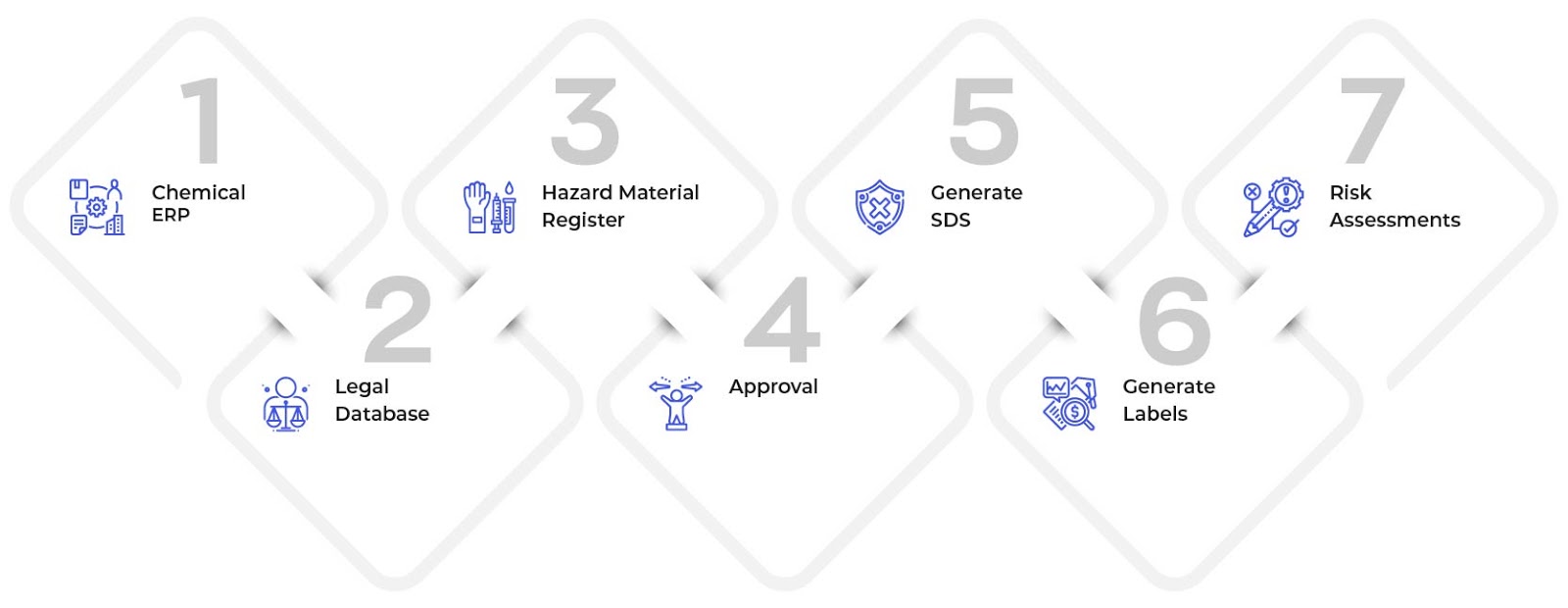AT A GLANCE
- The Globally Harmonized System of Classification and Labeling of Chemicals (GHS) offers a blueprint for handling hazard information through labels and safety data sheets.
- OSHA raised its penalties related to occupational hazards almost by 1.8% on 15th January 2020. Any violation of the recognized safety standards would cost a chemical manufacturer a whopping fine ranging from $9,639 to $134,937.
- GHS compliance effectively minimizes labor costs owing to fewer accidents and health problems.
For any drug or chemical manufacturing company, GHS compliance guide rests on four central pillars: Hazard classification, Chemical Labels, Safety Data Sheets and Employee Training. For chemical companies across the globe, it’s an ongoing challenge to remain compliant with GHS standards in the face of ever-changing regulations. For just about any chemical manufacturer, the task of collating and reporting on every available data point through safety data sheets and chemical labels can be almost impossible. This necessitates the need to adopt chemical industry-specific software solutions that help generate and manage safety data sheets and labels according to GHS guidelines. These software solutions enable companies to:
- Create a safer work environment for all employees across multiple manufacturing units.
- Automate critical chemical management processes like GHS labeling and generating Safety Data Sheets.
- Boost process efficiency and reduce fines incurred from breaches in compliance.
- Leverage employee training mechanisms, expert resources and applications that focus on the handling and disposal of hazardous chemicals.
- Converge multiple operational functions in a single dashboard for smart analysis.
- Conduct training programs on employee safety.
- Build credibility and brand recognition in the market.
FIGURE 1:Key Operational Principles of a Chemical Management System

The image above makes it very clear that for GHS compliance, the two most critical working processes in a chemical management system include GHS Labeling and Safety Data Sheets. Let’s focus on how a Chemical Management ERP system lends itself to GHS labeling and SDS chemical management automation.
Chemical Labeling and GHS
Chemical labeling is all about conveying critical hazard information related to a particular chemical at a rudimentary level. Six key elements make up the chemical labels, including.
- 1.The Signal Word
- 2.GHS Symbols or Hazard Pictograms
- 3.Manufacturer Information
- 4.Precautionary Statements
- 5.Hazard Statements, and
- 6.Identifiers
FIGURE 2:GHS Compliant Chemical Label
With regulations constantly changing, chemical manufacturers are persistently working towards adopting technologies that seamlessly work with their existing systems to deliver process efficiency and compliance at the same time. Before understanding how the chemical industry has worked towards mitigating challenges, it’s important to understand the most harrowing challenges plaguing the labeling process of the chemical industry, including
- Identifying relevant, compliant data to be put on container labels.
- Finding labels that are durable and can withstand the impacts of harsh chemicals.
- Finding the correct size for GHS labels for containers of different size.
When it comes to chemical management, labeling is one of the most critical tasks. It’s only through proper labeling that companies can track chemicals from manufacturing to delivery. Most chemical industry software solutions based on the ERP framework deliver the following solutions to the problems mentioned above, including.
- An infrastructure to house hazard information such as pictograms, hazard statements, provisions for inserting supplier information, etc.
- Provision for customization of GHS chemical labels for different sizes used on various containers.
These benefits are very tangible and apparent, but technical intervention in labeling can be much greater, encompassing the entire business.
Business Benefits of GHS Labeling
- Boost Supply Chain
- Track chemicals with all the requisite details.
- Minimize re-labeling, incorrect shipments, inventory problems.
- Change Management
- Implement change real time.
- offer standard templates and system for change Management.
- Cost Efficiency
- Minimize shipping delays, unnecessary operational steps.
- Error proofing and data management.
- Compliance
- Integrate third parties in labelling systems.
- Minimize manual shipments.
- Process Efficiency
- Integrate marketing and branding information.
- Manage multiple languages, color printing, regulatory standards.
- Business Expansion
- Retrieve data from multiple systems.
- Minimize duplication for a single product.
OSHA has raised its penalties related to occupational hazards almost by 1.8% at the start of 2020. Any violations of these recognized safety standards would cost a chemical manufacturer any number of fines ranging from $9,639 to $134,937.
It’s not just GHS labeling requirements, but complete SDS chemical management solutions that would best help chemical manufacturers minimize their chances for huge financial penalties, driving process efficiency along with compliance at the same time.
Safety Data Sheets and GHS
Safety Data Sheets (SDS) are used to capture all hazardous chemicals’ information. SDS is not only the first point of hazard information collection and reporting. The safety data sheet form the basis of GHS labeling. With the business ecosystem becoming extraordinarily dynamic and constantly changing, becoming more stringent, there can be absolutely no room for error in safety data sheets. Chemical companies opt for SDS authoring and generation software that work in tandem with their existing ERP system. These SDS tools bring a lot to the table for these organizations, including:
- Real-time safety data sheet updating features
- Seamless integration with existing ERP systems
- Automatic generation of SDS sheets
- Storage capacity for individual product data
- Applications to update multiple sheets at the same time
- Options for multiple language translations
- Ability to create standardized data for every chemical formulation
- Repository for multiple GHS versions, Canadian WHMIS, and OSHA Hazcom
Integrated Chemical Management (iCM) is a solution designed to offer both GHS labeling and SDS chemical management services simultaneously. This solution pairs with Microsoft’s Dynamic 365 ERP to deliver:
- Real-time SDS authoring and label creation at the same time in compliance with GHS.
- Deliver process automation and operational efficiency.
- Minimize the cost of customization and third-party integration cost.
- Minimize the time and resources required to manage data sheets and labels.
Key Takeaways:
- Managing multiple third parties for SDS management and GHS labeling can be a challenge. Implementing a powerful, integrated solution that does both can make a huge impact on efficiency and performance.
- Process and compliance in a chemical company go hand in hand, and the more the integration is facilitated, the better it is for optimizing operations within the plant.
- Being Agile through integrated technologies is a crucial need in chemical manufacturing and the ability to respond quickly to changes in compliance makes a chemical company potent as a business.
Take Our Free Assessment to Get Started With Digital Transformation








